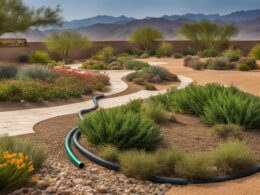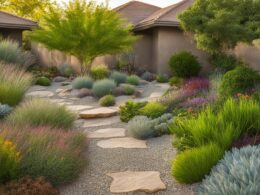Controlling weeds in xeriscape landscapes can be challenging, but with the right techniques, you can minimize weed growth and conserve water. In this section, we will explore various methods and strategies for effective weed control in xeriscape gardens.
- Using mulch is a highly effective way to suppress weed growth in xeriscape gardens.
- Proper plant selection plays a crucial role in minimizing weed growth and conserving water.
- Non-chemical weed control options, such as hand-pulling and cultivation, can be employed in xeriscape landscapes.
- Designing the landscape with weed control in mind can help prevent weed growth from the outset.
- Controlling existing weeds before planting is essential to ensure the success of your xeriscape garden.
Designing with Weed Control in Mind
When it comes to designing a xeriscape garden, weed control should be an integral part of the planning process. By incorporating strategies that discourage weed growth from the start, you can create a beautiful and low-maintenance landscape that minimizes the need for constant weeding. The following design principles and techniques can help you achieve this:
- “Right plant, right place”: Selecting plants that are well-suited to your specific climate, soil type, and sunlight conditions can help create a dense planting that discourages weed growth. When plants are healthy and thriving, they can outcompete weeds for resources and minimize open spaces where weeds can take hold.
- Dense planting: Planting your garden with a dense arrangement of plants can help shade the soil and reduce the available space for weeds to grow. Consider using groundcovers, grasses, and shrubs to fill in empty spaces and prevent weed colonization.
- Fast-growing groundcovers: Incorporating fast-growing groundcovers in your xeriscape design can be an effective strategy for weed control. These plants spread quickly and form a dense mat that inhibits weed growth. Examples of fast-growing groundcovers include creeping thyme, creeping phlox, and sedums.
In addition to these design techniques, selecting native ornamental species for your xeriscape can further enhance weed control efforts. Native plants are well-adapted to the local environment, making them more resilient and less susceptible to weed competition. They also provide habitat for beneficial insects and wildlife, contributing to a balanced ecosystem.
Implementing proper cultural practices is also crucial for effective weed control in xeriscapes. This includes regular maintenance tasks such as removing weeds by hand, cutting back spent flowers to prevent seed dispersal, and maintaining a layer of mulch to suppress weed growth. By taking a proactive approach to weed control in the design and maintenance of your xeriscape garden, you can enjoy a beautiful and weed-free landscape that conserves water and reduces maintenance costs.
Controlling Weeds before Planting
Before you start planting in your xeriscape garden, it’s essential to take control of existing weeds. If you neglect this step, weeds can quickly overtake your new plantings and undermine your efforts to create a low-maintenance landscape. Here are some effective strategies to consider:
- Herbicide Application: Herbicides can be a useful tool for weed control before planting. Glyphosate, a non-selective herbicide, is commonly used to kill existing weeds. However, it’s important to choose the right herbicide for your specific needs and follow the instructions carefully to avoid harming your future plantings.
- Tilling and Hoeing: Another method to deplete the weed seed bank is by tilling and hoeing the soil. This physically disrupts the weeds’ root systems and brings buried weed seeds to the surface, allowing you to remove them before planting. However, be cautious not to disturb the soil structure excessively, as this can lead to erosion and loss of soil moisture.
- Soil Solarization: Soil solarization is a heat-based method that can effectively eliminate pests, pathogens, and weed seeds in the soil. By covering the planting area with a clear plastic sheet and allowing the sun to heat the soil, you can create an inhospitable environment for weed growth. This technique is particularly beneficial for areas with persistent weed problems.
Proper Weed Control for Successful Planting
Controlling weeds before planting is crucial to ensure the success of your xeriscape garden. By employing a combination of herbicides, tilling and hoeing, and soil solarization, you can effectively reduce weed competition and give your new plantings the best possible start. Remember to choose the appropriate weed control method based on your garden’s specific needs and follow recommended practices for optimal results.
What Are the Best Weed Control Techniques for Xeriscaping?
When it comes to creating a low-maintenance xeriscape garden, mastering the use of ground covers is essential for effective weed control. Some of the best master xeriscape ground covers include creeping thyme, sedum, and ice plant. These plants not only help prevent weed growth but also add visual appeal to the landscape.
Controlling Weeds after Planting
Once you’ve planted your xeriscape garden, it’s important to take proactive measures to control weeds and maintain the beauty of your landscape. Mulching is a highly effective strategy that not only suppresses weed growth but also improves soil quality and reduces the need for irrigation. Spread a layer of organic mulch, such as bark chips or straw, around your plants to prevent weeds from sprouting and competing for resources.
If you prefer non-chemical methods, regular hand-pulling and cultivation can be effective in removing weeds. Be sure to pull out the entire weed, including the roots, to prevent regrowth. Cultivating the soil around your plants can disrupt weed growth and expose their roots to air and sunlight, causing them to wither and die.
However, if herbicides are necessary, it’s crucial to choose selective options and apply them according to label instructions. Target the specific weeds you want to eliminate while minimizing harm to surrounding plants. Always follow safety precautions and avoid using herbicides near water sources or on windy days to prevent contamination and unintended damage.
Key Takeaways:
- Mulching is an effective weed control strategy that also improves soil quality and reduces irrigation needs.
- Regular hand-pulling and cultivation can be used to remove weeds without chemical intervention.
- If herbicides are necessary, choose selective options and apply them with caution following label instructions.
Conclusion
In conclusion, xeriscape gardens offer a sustainable and low-maintenance solution for homeowners looking to conserve water and reduce maintenance costs. With the right techniques and strategies, you can effectively control weeds in your xeriscape landscape while enhancing its overall beauty.
By implementing proper plant selection and designing with weed control in mind, you can create a dense and thriving garden that naturally suppresses weed growth. Native ornamental species, dense planting, and the use of fast-growing groundcovers can further minimize weed growth and reduce the need for constant maintenance.
Controlling weeds before planting is crucial to creating a weed-free environment for your xeriscape garden. Whether through the use of herbicides, tilling and hoeing, or soil solarization, eliminating existing weeds and reducing the weed seed bank will set the stage for successful plantings in the future.
Once your xeriscape garden is established, ongoing weed control is necessary to maintain its aesthetics and health. Mulching proves to be an effective method, providing multiple benefits such as weed suppression, improved soil quality, and reduced water requirements. Non-chemical methods like hand-pulling and cultivation can also be used, with selective herbicides being a last resort and applied as directed on the label.
In conclusion, with careful planning, diligent weed control techniques, and the implementation of these strategies, you can create a beautiful, sustainable, and low-maintenance xeriscape garden that minimizes weed growth and maximizes your enjoyment of your outdoor space.












